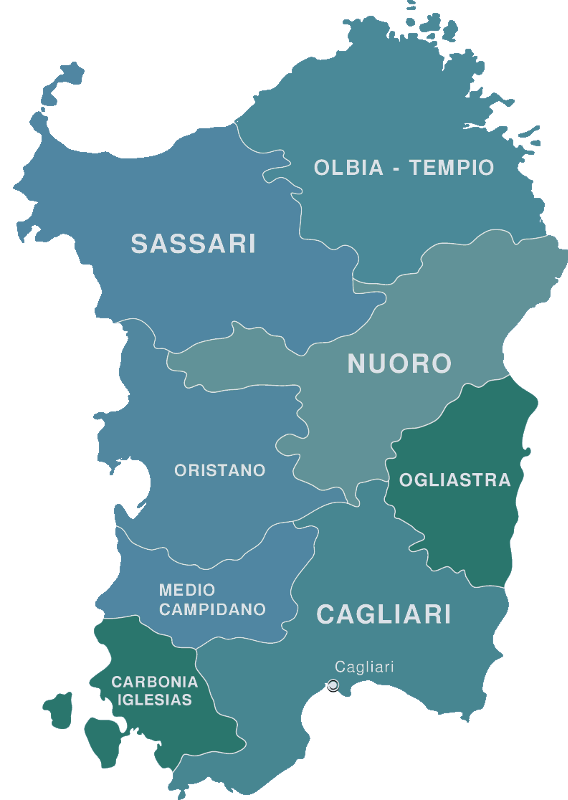


Practical Information

About Sardinia
Sardinia is the second largest Italian island and is situated in the middle of the Mediterranean Sea. With over 1840 km of coastline, it is has Italy's longest coast. The Greeks called it Hyknusa or Ichnussa (Ιχνουσσα), from the Greek ichnos (footprint of the human foot) because of its resemblance to a large footprint. Sardinia, however, takes its name from the Latin Sardinia, as the Romans called it.
There are numerous historical and archaeological sites in the region including: Nuraghi (the most famous), menhirs, sacred wells, tombs of the giants and “Domus de Janas”. All of these make Sardinian scenery truly one of a kind.
Sardinia is also called “the other continent,” because it has been at the centre of Western civilization for millennia and is still remote, independent and timeless. Recently, a research team discovered that in the modern Sardinian population the DNA of ancient hunter and gatherer populations survives, which lived on the island 12 thousand years ago. This is an exceptional discovery that underlines the uniqueness of the genetic heritage of Sardinians, linked to the isolation that has lasted for millennia.
Many people consider Sardinia the “least Italian” among all the regions because of its geographical isolation. This has led to the development of very distinct native animal and vegetable species (such as the mouflon or the white donkey of the Asinara). It also has a very particular language and ancient traditions, which have remained intact over the centuries.
Interestingly, Sardinia is known as one of the 5 countries in the world with the highest number of centenarians, together with the village Loma Linda (in California), the peninsula of Nicoya (in Costa Rica), the island of Ikaria (in Greece) and Okinawa (in Japan). There's no definitive answer why this is, however, some scientists believe that the secret lies in the genetics, daily diet, and special way of life in these areas.
How to Travel to Sardinia
Holidaying in Sardinia is very easy. Cagliari Elmas Airport is the main international gateway to Sardinia as it is connected to most major European destinations. This airport is situated in the South of Sardinia where it is easy to reach tourist destinations such as Villasimius, Pula, Teulada, Sant'Antioco Island, San Pietro Island (Carloforte) Iglesias, and Costa Verde.
Other airports in Sardinia are:
Olbia Costa Smeralda Airport - Northeast
Alghero-Fertilia "Riviera del Corallo" Airport - Northwest
Sardinia, being located in the centre of the Mediterranean, is also easily accessible by sea. Numerous ferry lines such as Sardinia Ferries, Tirrenia and Moby connect it to the mainland (Rome, Genoa and Naples) but also to other countries such as France and Spain.
From which country can you fly directly to Cagliari - Sardinia?
In total there are 67 airports around the world that have direct flights to Cagliari, spread around 59 cities in 17 countries. Here is the entire list.
Which airlines fly to Cagliari from London?
-Ryanair flies from London Stansted to Cagliari-Elmas Airport (check the official website for the schedule).
-British Airways flies from London Gatwick to Cagliari-Elmas Airport (check the official website for the schedule).
-Easyjet flies from London Gatwick to Cagliari-Elmas Airport (check the official website for the schedule).
How long is the flight to Cagliari?
Flights from London take around 2h 30m. The longest flight to Cagliari is from Gothenburg (GOT). This non-stop flight takes around 3 hours and 15 minutes.
Is it possible to fly directly from Ireland to Sardinia?
Ryanair and Aer Lingus offer direct flights to Sardinia.
Alternatively, you can travel from the UK to Sardinia by car.
After arriving to France from the English Channel there are many routes available from France and Italy to reach Sardinia:
- Marseilles to Porto Torres (North West coast)
- Civitavecchia (Rome) to Golfo Aranci or Olbia (North East coast)
- Genova to Porto Torres or Olbia
Once in the north of Sardinia, you can quickly drive to Cagliari.
Rent a Car
NxtStop Sardinia can help you to rent a car, contact us.
Driving in a car is the best way to travel in Sardinia and will allow you to explore the island. You will be able to discover the spectacular beaches and coves, experience the diverse scenery and views and visit some of the towns, villages and historical sites. There are no motorways in Sardinia but there are 'A, roads connecting the major cities.
Where can I rent a car in Southwest Sardinia?
There are car hire companies on site at Cagliari-Elmas airport including Avis, Europcar, Hertz, These have counters conveniently located within the arrivals section of the airport. Cagliari Airport is located just over 10 km (6 miles) from the city centre.
Please note: It is best to hire a car before arriving in Cagliari, especially in the summer months. NxtStop Sardinia can help you rent a car, contact us.
On average a car hire in Cagliari costs £45 per day, depending on the time of the year; summer is more expensive.
Filling up a tank of fuel costs between £55 and £75, depending on the car size.
Can I drive to Italy on a UK driving licence after Brexit?
From 1 January, most UK drivers will still be able to use their normal driving licence to drive in EU countries. There are some exceptions and you may need to purchase an International Driving Permit (IDP can be bought at Post Offices for £5.50). These exceptions are for people who only have a paper licence, not a photocard one, as well as those with licences issued in Gibraltar, Guernsey, Jersey or the Isle of Man.
Rules to Follow
Don't take sand, pebble and shell from Sardinia (If you take anything on an airplane, scanners will see these. The sand will be confiscated and you will get a hefty fine).
Pick up your litter and beware of plastic objects and cigarette butts. These are death traps for many marine animals (plastic bottles, bags, plates and cups take 100 to 1000 years to degrade).
Don't light fires. In Sardinia the summer is very dry and therefore very susceptible to fire. So it is forbidden to light fires, even for cooking purposes, if not in a dedicated picnic area.
Covid 19 Updates
Covid-19 Travel requirements for entering Italy
All travellers
Travellers are no longer required to complete a Passenger Locator Form (EU PLF) to enter or travel through Italy as a visitors.
COVID-19 restrictions on entering Italy have been lifted. Italy does not require any proof of vaccination, a negative test result, or a COVID-19 recovery certificate to enter the country, regardless of your vaccination status.
Travellers arriving in Italy, including minors, may be subject to random COVID-19 testing in airports and ports.
Masks are no longer required on flights in, to or from Italy.
Covid-19 Travel requirements for entering the UK
You do not need to complete a UK passenger locator form before you travel, take any COVID-19 tests or quarantine when you arrive in England.
For further information – https://tinyurl.com/43ebeyfb
For the most up-to-date travel advice including information on safety, security and health, local rules and currency, please visit 'Travel Aware' and the 'Foreign travel Advice' Government website.
https://travelaware.campaign.gov.uk/
https://www.gov.uk/foreign-travel-advice/italy
Please note that the rules can change at any time, so check regularly for updates.


